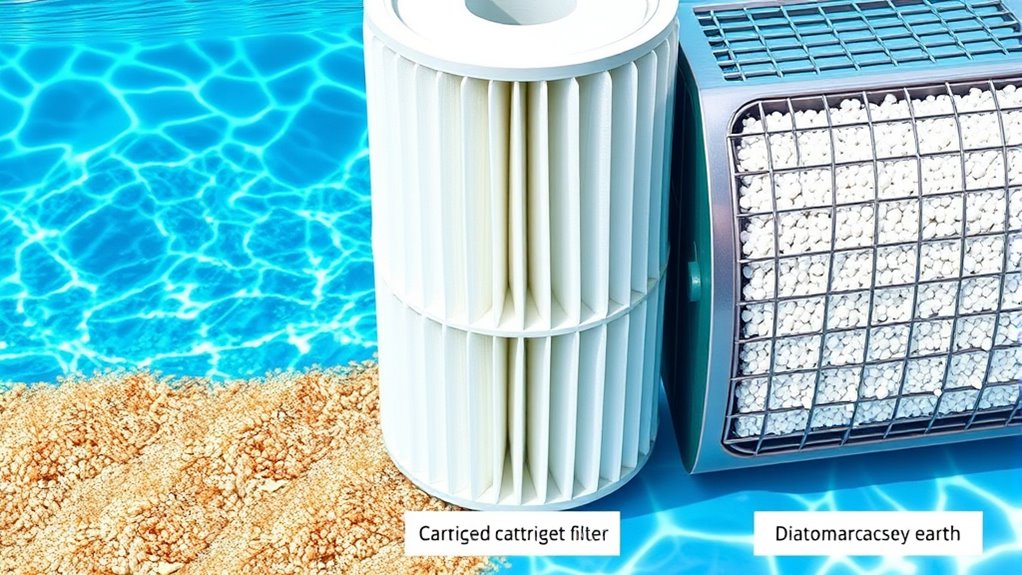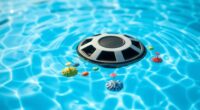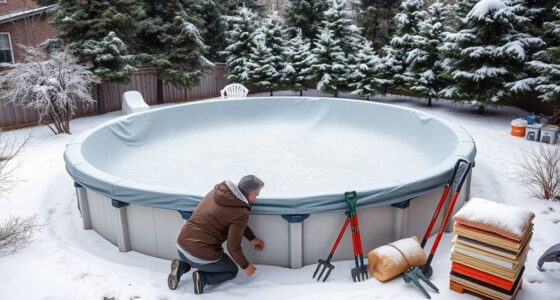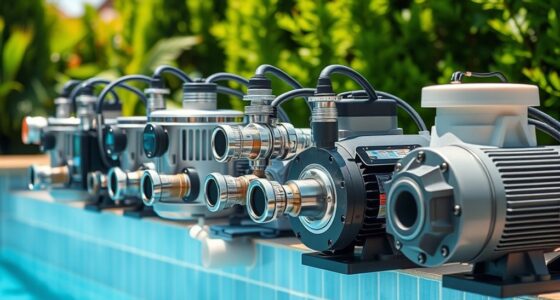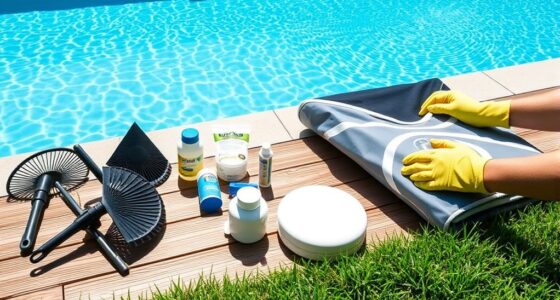Your pool filtration system keeps your water clean by using different filters—sand, cartridge, and DE. Sand filters trap dirt in tiny spaces between graded sand, requiring regular backwashing. Cartridge filters use pleated cartridges to catch finer particles, needing periodic cleaning or replacement. DE filters coat grids with diatomaceous earth, capturing the tiniest debris for crystal-clear water. Understanding how each filter works helps you choose and maintain your system better. If you explore further, you’ll learn more about keeping your pool sparkling.
Key Takeaways
- Pool filtration systems use different filters—sand, cartridge, and DE—to physically trap dirt, debris, and impurities from water.
- Sand filters operate with a bed of graded sand that captures particles, requiring periodic backwashing to remove accumulated debris.
- Cartridge filters utilize pleated cartridges that trap finer particles and are easy to clean or replace when dirty.
- DE filters coat grids with diatomaceous earth powder, creating a fine barrier that filters tiny particles for ultra-clear water.
- Proper maintenance of each filter type ensures efficient operation, extends lifespan, and maintains clean, safe pool water.
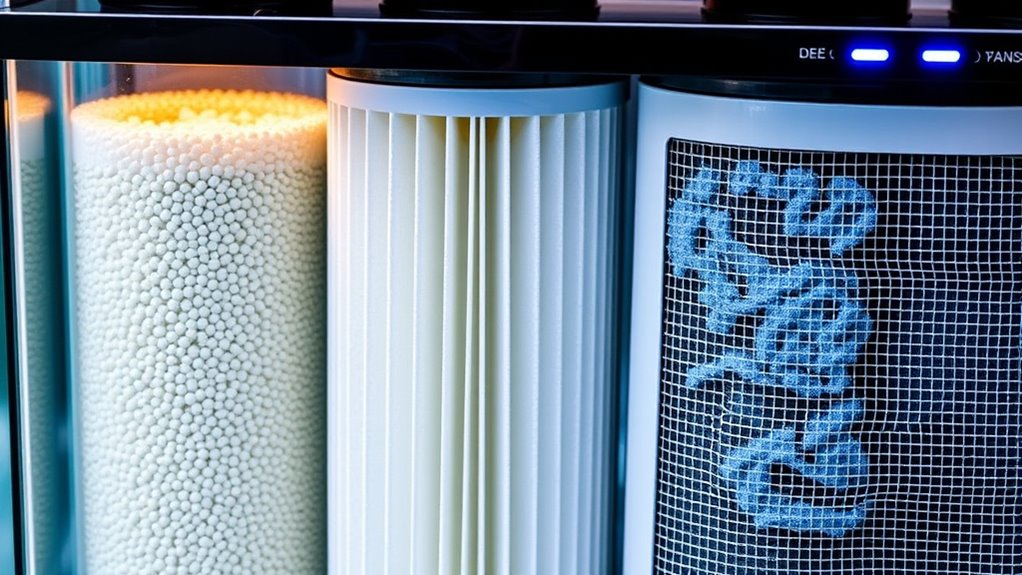
Have you ever wondered how pools stay clean and clear? It’s all thanks to the pool filtration system, which works tirelessly to keep your water inviting and safe. The core of this system involves different types of filters—sand, cartridge, and DE—that trap dirt, debris, and other impurities. These filters rely on a combination of physical barriers and chemical treatments to maintain water quality. While chemical treatments help disinfect and balance the water chemistry, the filters physically remove particles, ensuring the water remains transparent. Modern filtration systems are also designed with energy efficiency in mind, helping you save on electricity while keeping your pool in top condition.
Sand filters are one of the most common and straightforward options. They use a bed of specially graded sand to trap particles as water is pushed through the filter. When the water flows through, dirt and debris get caught in the tiny spaces between the sand grains. Over time, the filter becomes less effective, so you need to backwash it—reversing the flow of water to flush out accumulated debris. Sand filters are relatively low-maintenance, and since they don’t require frequent replacement, they’re cost-effective. Plus, they’re energy-efficient because they operate with a simple pump and don’t demand high power levels. This makes them a popular choice for many pool owners looking to balance performance with energy savings. Additionally, proper maintenance of the filtration system helps prolong its lifespan and efficiency.
Sand filters are low-maintenance, cost-effective, and energy-efficient options for keeping your pool clean.
Cartridge filters work differently. They use a replaceable cartridge element made of pleated polyester or similar material, which captures dirt as water passes through. These filters are highly effective at trapping finer particles, resulting in clearer water. They’re also easy to maintain—just remove and clean or replace the cartridge when it gets dirty. Cartridge filters tend to operate with less pressure, which means your pump doesn’t need to work as hard, translating into lower energy consumption. This makes them not only efficient but also convenient, especially if you prefer a straightforward maintenance routine. They’re ideal for pools that see moderate use and where water clarity is a priority.
Diatomaceous Earth (DE) filters take filtration a step further. They use a fine powder made from fossilized diatoms, which coats a grid or manifold to create an ultra-fine filter. Water passes through this coating, trapping very small particles that other filters might miss. DE filters produce the clearest water and are especially effective at removing tiny debris. However, they require more maintenance—they need to be recharged with new DE powder periodically and cleaned thoroughly to keep them functioning properly. While they might consume more energy during operation, their superior filtration can reduce the load on your chemical treatments, helping you maintain balanced, safe water with fewer chemicals. Overall, DE filters are a great choice if maximum clarity and filtration are your priorities. In recent years, advancements in filter technology have improved energy efficiency and ease of maintenance for all types of pool filters.
In the end, understanding how each filter type works helps you choose the most energy-efficient and effective system for your pool. Proper maintenance, combined with appropriate chemical treatments, ensures your water stays clean, clear, and inviting all season long.
Frequently Asked Questions
How Often Should I Replace Each Type of Filter?
You should replace your pool filters based on their maintenance schedule. Sand filters typically last 5-7 years before needing replacement, while cartridge filters usually require replacement every 1-2 years, depending on use. DE filters often last 3-5 years before a thorough cleaning or replacement. Regular filter maintenance extends their life, so check your manufacturer’s guidelines and perform routine cleanings to keep your pool crystal clear and functioning efficiently.
Can I Use Multiple Filtration Systems Together?
Think of your pool as a symphony needing harmonious instruments. You can use multiple filtration systems together, boosting multi system efficiency and filtration compatibility. Combining sand, cartridge, and DE filters helps target different debris and improve water clarity. Just make certain they work well together and aren’t overtaxed, which might reduce effectiveness. Properly coordinated, these systems enhance your pool’s cleanliness, much like a well-conducted orchestra producing a perfect melody.
What Is the Best Filter for a Small Pool?
For a small pool, a cartridge filter is your best choice because it’s easy to maintain and effective at keeping the water clear. It works well with your pool chemistry, filtering out debris and contaminants without needing backwashing like sand or DE filters. Regular filtration maintenance guarantees your pool stays clean and safe. Plus, cartridge filters are compact and energy-efficient, making them ideal for small pools.
How Do I Know When My Filter Needs Cleaning?
Think of your filter like a coffee filter—if it’s clogged, your pool’s water circulation slows down, and clarity drops. You’ll notice murky water, floating debris, or a decrease in flow rate. Regularly check your pool chemistry and clean the filter when flow diminishes or water looks cloudy. Staying attentive guarantees your filter works efficiently, keeping your pool sparkling and safe for swimming.
Are There Eco-Friendly Options for Pool Filtration?
Yes, there are eco-friendly alternatives for pool filtration. You can choose biodegradable filter media that break down naturally, reducing environmental impact. Some filters use natural materials like coconut shells or plant-based fibers, which are sustainable options. These eco-friendly options often require less chemical treatment and are safer for the environment, helping you maintain a clean pool while minimizing your ecological footprint.
Conclusion
Now that you understand how sand, cartridge, and DE filters work, you can choose the best system for your pool. Imagine you’re hosting a summer party; a clean, crystal-clear pool will impress your guests. For example, switching to a DE filter improved water clarity in a friend’s pool, making it perfect for swimming and relaxing. With the right filtration system, you’ll enjoy sparkling, inviting water all season long.
